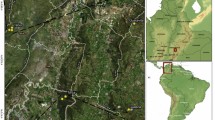Abstract
The paper provides information on the distribution of coltsfoot (Tussilago farfara L.) in the south of Primorsky Territory (the Russian Far East). It is established that, in the study area, the species is massively found along the roadsides and inhabits anthropogenic landscapes (gardens, abandoned fields, wastelands in cities and towns), and a single case of introduction into the forest biocenosis on the territory of the Ussuri Nature Reserve is noted. According to the degree of naturalization, the species can be attributed to epecophytes, the self-renewal and naturalization of which is possible only among anthropogenic vegetation in disturbed and artificial habitats. It is necessary to continue monitoring of its distribution in the region to prevent the introduction into natural biocenoses.

Similar content being viewed by others
REFERENCES
Antonova, L.A., Konspekt adventivnoi flory Khabarovskogo kraya (A Summary of the Adventitious Flora of the Khabarovsk Territory), Vladivostok: Far East Branch, Russ. Acad. Sci., 2009.
Dronin, G.V., Alien plant species in the Syzranka River basin, Izv. Sarat. Univ., Nov. Ser., Chem., Biol.,Ecol., 2017, vol. 17, no. 1, pp. 98–102.
Fedina, L.A., The stranger Tussilago farfara (Asteraceae) in the Ussuri Nature Reserve (Primorsky Territory), Bot. Zh., 2018, vol. 103, no. 7, pp. 919–922.
Flora rossiiskogo Dal’nego Vostoka: dopolneniya i izmeneniya k izdaniyu “Sosudistye rasteniya sovetskogo Dal’nego Vostoka” (1985–1996) (Flora of the Russian Far East: Additions and Modifications to the Edition “Vascular Plants of the Soviet Far East” (1985–1996)), Kozhevnikov, A.E. and Probatova, N.S., Eds., Vladivostok: Dal’nauka, 2006, vols. 1–8.
Kolyada, N.A. and Kolyada, A.S., Occurrence of potentially invasive species box elder (Acer negundo L.) in the south of the Russian Far East, Russ. J. Biol. Invasions, 2017, vol. 8, pp. 41–44.
Kolyada, N.A. and Kolyada, A.S., Occurrence of Amorpha fruticosa L. in the south of the Russian Far East, Russ. J. Biol. Invasions, 2018a, vol. 9, pp. 53–56.
Kolyada, N.A. and Kolyada, A.S., Robinia pseudoacacia L. (Fabaceae Lindl.) in the south of the Russian Far East, Russ. J. Biol. Invasions, 2018b, vol. 9, pp. 215–218.
Kolyada, N.A. and Kolyada, A.S., Findings of the invasive species Acanthoscelides pallidipennis (Motschulsky, 1874) on Amorpha fruticosa L. in Primorsky krai, Russ. J. Biol. Invasions, 2019, vol. 10, pp. 157–159.
Kozhevnikov, A.E. and Kozhevnikova, Z.V., Complex of adventitious plant species as a component of the natural flora of the Russian Far East: diversity and spatial changes in the taxonomic structure, Komarovskie Chteniya, 2011, no. 58, pp. 5–36.
Kuprin, A.V., Kolyada, N.A., and Kasatkin, D.G., New invasive species Acanthoscelides pallidipennis (Motschulsky, 1874) (Coleoptera: Bruchidae) in the fauna of the Russian Far East, Far East. Entomol., 2018, no. 360, pp. 25–28.
Nechaeva, T.I., Adventitious flora of Primorsky Territory, Komarovskie Chteniya, 1984, no. 31, pp. 46–99.
Richardson, D.M. and Pyšek, P., Naturalization of introduced plants: ecological drivers of biogeographical patterns, New Phytol., 2012, vol. 196, pp. 383–396.
Richardson, D.M., Pyšek, P., Rejmanek, M., Barbourm, M.G., Dane, P.F., and West, C.J., Naturalization and invasion of alien plants: concepts and definitions, Divers. Distib., 2000, no. 6, pp. 93–107.
Sosudistye rasteniya sovetskogo Dal’nego Vostoka (Vascular Plants of the Soviet Far East), Kharkevich, S.S., Ed., St. Petersburg: Nauka, 1992, vol. 6.
Vinogradova, Yu.K., Kuklina, A.G., and Tkacheva, E.V., Invazionnye vidy semeistva Bobovykh. Lyupin, Galega, Robiniya, Amorfa, Karagana (Invasive Species of the Legume families Lupin, Galega, Robin, Amorpha, and Karagan), Moscow: ABF, 2014.
Vorob’ev, D.P., Inflow and weedy plants in Primorsky Territory, Komarovskie Chteniya, 1954, no. 4, pp. 3–22.
Vorob’ev, D.P., Opredelitel’ sosudistykh rastenii okrestnostei Vladivostoka (Determinant of Vascular Plants in the Vladivostok’s Vicinity), Leningrad: Nauka, 1982.
Voroshilov, V.N., Opredelitel’ rastenii sovetskogo Dal’nego Vostoka (Determinant of Plants in the Soviet Far East), Moscow: Nauka, 1982.
ACKNOWLEDGMENTS
We express our deep gratitude to the administration of the Ussuri Nature Reserve and the employees of the protection department for their assistance in conducting field studies and collecting material.
Funding
This work was performed as part of state assignments nos. AAAA-A17-117062710084-7 and AAAA-A18-118052400130-7.
Author information
Authors and Affiliations
Corresponding authors
Ethics declarations
COMPLIANCE WITH ETHICAL STANDARDS
The article does not contain any studies involving animals in experiments performed by any of the authors.
CONFLICTS OF INTEREST
The authors declare that they have no conflict of interest.
Rights and permissions
About this article
Cite this article
Fedina, L.A., Kuprin, A.V. & Ogorodnikov, E.M. Tussilago farfara (Asteraceae) in the South of the Far East of Russia. Russ J Biol Invasions 11, 88–91 (2020). https://doi.org/10.1134/S2075111720010038
Received:
Revised:
Accepted:
Published:
Issue Date:
DOI: https://doi.org/10.1134/S2075111720010038




